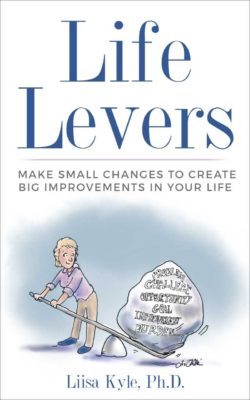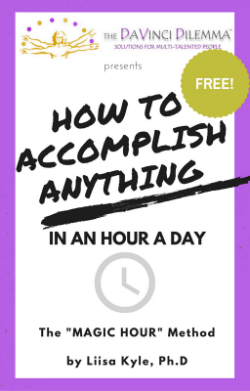
By Jessie Eastland [CC BY-SA 4.0 (https://creativecommons.org/licenses/by-sa/4.0)], from Wikimedia Commons
Now think about a really good day you’ve had. You wake up and all seems right with the world. You look forward to pleasant things unfolding during the day . . . and, gosh . . . they do. Pleasant surprises occur to delight you. Your heart swells. People around you smile. At the end of the day, you reflect back and think about how good your life is.
How we frame our intentions for the day can have huge implications for how it unfolds. If we expect to have a good day, we do. If we don’t, we don’t.
You may well balk, saying something like, “Well it all depends on what happens during the day. I have no control over what happens.”
Yes, things happen. “Bad” things and “good” things occur every day. What differs, however, is how we process what unfolds. Ample research has shown that if we’re in a foul mood, “bad” events seem catastrophic, permanent, and a negative reflection on us, personally. If, in contrast, we’re in a positive frame of mind, “bad” events seem less severe, temporary, and external — having little to do with us, personally.
This doesn’t mean you need to be a naive PollyAnna, blithely believing that everything is hunky dory, regardless of reality. It means that, to the extent you expect to have a good day, you will. Whatever arises that is “bad”, you will process more rationally and you will deal with more effectively — without allowing it to define you as a person or otherwise ruin your life.
Even better, it’s easy to set yourself up to expect to have a good day. It’s as simple as taking a few moments early in your day to answer the question, “what would make today a good day?”. Make a list. Consider including:
* things you’d like to do — and that you expect you will do (e.g. finish that report; exercise for at least thirty minutes; listen to music). [Note: Avoid putting down a dozen ‘to do’s you have no hope of accomplishing before bedtime. Instead, only include activities you believe are do-able today].
* things you’d like to avoid (e.g. no complaining; no gossiping; no snacks between lunch and dinner)
* things you’d like to limit (e.g. a maximum of thirty minutes surfing social media; avoid checking email until noon; just one beer tonight)
Include at least one action step for whatever project or activity is your top priority or most fulfilling or most important to you.
Include at least one item devoted to your personal self-care. (e.g. eat a salad; have a nap)
Once you make your list, you have a choice:
Option 1: Keep your list with you and check off items as they occur.
Option 2: At the end of the day, review your list and check off those that manifested.
Personally, I prefer Option 1 because every time I put a checkmark beside an intention, it feels great and it gives me a little mood boost. It’s also cumulative: The more good things I see happening during the day, the more I enjoy the day, the more positive my outlook, the more pleasant my experiences, and so forth.
When I give this assignment to my coaching clients, they may be skeptical at first but as soon as they try it, they see the benefits. They feel better. They get more done. They are more pleasant to be around so they see a marked improvement in their personal and professional interactions and relationships. They look forward to the next day.
Many of the strongest skeptics become zealots for the technique, practicing it daily and encouraging others to do the same.
Try this activity tomorrow. See what happens.
***
Activity: Tomorrow morning, make arrangements to spend five minutes first thing (or as early as you can fit into your day).
Ask yourself: what elements would make today a good day? Write down a list. Consider things you’d like to do — or not do. Include at least one action step for whatever project or activity is most important to you as well as at least one item of self-care.
Option 1: Keep your list with you and check off those items that manifest, as they occur.
Option 2: At the end of the day, review your list and check off those that manifested.
Bonus activity: repeat this activity several more times this week.
***
Variation: A Very Good Day
If the Good Day technique works well for you, consider this variation: As you make your “Good Day” list, make a short list alongside it answering the question, “What would make this a VERY Good Day”. Select a few items, including:
* one activity you’d really *like* to do but doubt you’ll have time for today (e.g. an hour in my workshop/studio). [The idea here is to highlight what would be tops on your list if you find some extra time. This way, if you do manage to fit it into your day, it’ll be a happy bonus — but if it doesn’t get done, it’s not frustrating or disappointing…it just didn’t get done today].
* something pleasant but out of your control (e.g. I receive great news; a new client calls me out of the blue)
Again, you can either keep your “Good Day” and “Very Good Day” lists with you and check them off during the day or do a review of your list at the end of the day.
Now what my coaching clients and I find is that, when we actually write down a few items that would make the day “very good”, they often happen. When they do, it’s very gratifying.
Note that I use the term “Very Good Day” rather than “Perfect Day” or “Ideal Day” or “Very Special Day” because wow that’s a lot of pressure. Especially if you are making this a daily practice. However I have had a few clients who responded better to the stronger terms. It’s up to you. Use the phrasing that clicks for you, given your unique personality, preferences, experiences, and circumstances.
Which leads me to the next version of this technique.
Variation: Personalized to Your Top Priority
Another option is to tailor the daily morning question to whatever is most important for you. Think about what is your top priority and frame your daily list accordingly. For example:
What would make this a healthy day for me?
What would make this a productive day for me?
What would make this a relaxing, peaceful day for me?
What would make this a meaningful or fulfilling day for me?
What would make this a lucrative day for me?
What would make this a spiritual day for me?
The possibilities are endless. However you choose to frame your day, that’s the day I wish for you.
***
 Want more tips and technique for getting things done? Check out my book YOU CAN GET IT DONE: Choose What to do, Plan, Start, Stay on Track, Overcome Obstacles, and Finish
Want more tips and technique for getting things done? Check out my book YOU CAN GET IT DONE: Choose What to do, Plan, Start, Stay on Track, Overcome Obstacles, and Finish
Available here in hardcover, paperback, and eBook formats: http://bit.ly/YouCanGetItDone
***
Want to re-publish this article? Go for it – just include the author’s name, a link to this original post and the following text blurb:
Are you struggling with too many talents, skills, ideas? You may have The DaVinci Dilemma™! Find tools, fun quizzes, coaching, inspiration and solutions for multi-talented people at http://www.davincidilemma.com/ .



